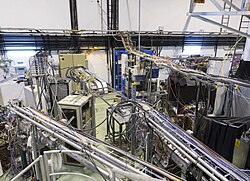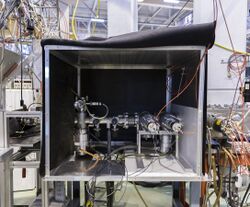Physics:COLLAPS experiment
The COLinear LAser SPectroscopy (COLLAPS) experiment is located in the ISOLDE facility at CERN. The purpose of the experiment is to investigate ground and isomeric state properties of exotic, short lived nuclei, including spins, electro-magnetic moments and charge radii.[1] The experiment has been operating since the late 1970s, and is the oldest active experiment at ISOLDE.[2][3]
Background
The technique of collinear spectroscopy was developed in the mid-1970s by S.L. Kaufman.[4] This describes a method of obtaining narrow absorption lines, specifically providing a sensitivity ideal for experiments on short-lived isotopes.
Two beams are used in the technique: a laser beam sent through the sample, and a probe beam. The alignment of both beams collinearly (along the same path) allow for control of the time and spatial overlap.[5] This enables investigation into the nuclear properties of the sample simultaneously.[6]
Experiment setup
COLLAPS is located within the ISOLDE facility at CERN, giving it access to the radioactive ions produced by ISOLDE's resonance ionisation laser ion source (RILIS).[7] The ions are delivered to the COLLAPS beamline and are excited using tunable continuous-wave lasers through the technique of collinear spectroscopy.[8][9] The laser systems produce laser light in the 210 nm to 1000 nm range with a narrow linewidth. The systems allow access to the atomic transitions necessary for the short-lived nuclei produced by ISOLDE.[3]
Laser spectroscopy is better performed on a neutral atom, and therefore a charge exchange cell (CEC) is needed to neutralise the ionic beam from ISOLDE.[7] A CEC neutralises the ions by causing the ionic beam to collide with the alkali vapours in the cell and transfer charge. Prior to entering the CEC, the ions are reaccelerated (retarded) and a scan of the atomic transition is taken using Doppler-tuning electrodes.[10] Laser spectroscopy is then performed on the neutral atom, however can also be performed directly on the ion. The detection system, located at the end of the beamline, consists of eight large-diameter aspheric lenses.[3] The atoms de-excite and release fluorescent light, which is transferred to the four photomultiplier tubes (PMTs) by the lenses.
Results
The following are some notable results from the COLLAPS experiment.[11][3]
- Charge radii, spins and electro-magnetic moments for various isotopes, including magic isotopes
- Developing the laser spectroscopy setup to examine very exotic isotopes[12]
- Found first direct evidence for the importance of proton and neutron excitations across shell gaps in ground state wave functions of neutron-rich Mn isotopes[13]
External links
References
- ↑ "COLLAPS | ISOLDE". https://isolde.cern/experiments/collaps.
- ↑ "Exploring nuclei at the limits" (in en-GB). 2020-09-18. https://cerncourier.com/a/exploring-nuclei-at-the-limits/.
- ↑ 3.0 3.1 3.2 3.3 "COLLAPS @ ISOLDE-CERN". http://collaps.web.cern.ch/subpages/experiment.html.
- ↑ Kaufman, S. L. (1976-06-01). "High-resolution laser spectroscopy in fast beams" (in en). Optics Communications 17 (3): 309–312. doi:10.1016/0030-4018(76)90267-4. ISSN 0030-4018. https://www.sciencedirect.com/science/article/pii/0030401876902674.
- ↑ Neugart, R; Billowes, J; Bissell, M L; Blaum, K; Cheal, B; Flanagan, K T; Neyens, G; Nörtershäuser, W et al. (2017-06-01). "Collinear laser spectroscopy at ISOLDE: new methods and highlights". Journal of Physics G: Nuclear and Particle Physics 44 (6): 064002. doi:10.1088/1361-6471/aa6642. ISSN 0954-3899. https://iopscience.iop.org/article/10.1088/1361-6471/aa6642.
- ↑ Wang, S. J.; Yang, X. F.; Bai, S. W.; Liu, Y. C.; Zhang, P.; Liu, Y. S.; Hu, H. R.; Li, H. W. et al. (2022-06-01). "Construction and commissioning of the collinear laser spectroscopy system at BRIF" (in en). Nuclear Instruments and Methods in Physics Research Section A: Accelerators, Spectrometers, Detectors and Associated Equipment 1032: 166622. doi:10.1016/j.nima.2022.166622. ISSN 0168-9002. https://www.sciencedirect.com/science/article/pii/S0168900222001942.
- ↑ 7.0 7.1 Heylen, H.; Devlin, C. S.; Gins, W.; Bissell, M. L.; Blaum, K.; Cheal, B.; Filippin, L.; Ruiz, R. F. Garcia et al. (2021-01-25). "High-resolution laser spectroscopy of $^{27--32}\mathrm{Al}$". Physical Review C 103 (1): 014318. doi:10.1103/PhysRevC.103.014318. https://link.aps.org/doi/10.1103/PhysRevC.103.014318.
- ↑ "The COLLAPS experiment at ISOLDE (CERN)" (in en). https://fys.kuleuven.be/iks/nm/the-heidelberg-leuven-mainz-manchester-collaboration-at-the-collaps-beam-line-at-isolde-cern.
- ↑ "Exploring nuclei at the limits" (in en-GB). 2020-09-18. https://cerncourier.com/a/exploring-nuclei-at-the-limits/.
- ↑ Wraith, C.; Yang, X. F.; Xie, L.; Babcock, C.; Bieroń, J.; Billowes, J.; Bissell, M. L.; Blaum, K. et al. (2017-08-10). "Evolution of nuclear structure in neutron-rich odd-Zn isotopes and isomers" (in en). Physics Letters B 771: 385–391. doi:10.1016/j.physletb.2017.05.085. ISSN 0370-2693. https://www.sciencedirect.com/science/article/pii/S0370269317304483.
- ↑ COLLAPS. "COLlinear LAser SPectroscopy @ ISOLDE-CERN.". http://collaps.web.cern.ch/collaps/.
- ↑ Ruiz, R F Garcia; Gorges, C; Bissell, M; Blaum, K; Gins, W; Heylen, H; Koenig, K; Kaufmann, S et al. (2017-04-01). "Development of a sensitive setup for laser spectroscopy studies of very exotic calcium isotopes". Journal of Physics G: Nuclear and Particle Physics 44 (4): 044003. doi:10.1088/1361-6471/aa5a24. ISSN 0954-3899. https://iopscience.iop.org/article/10.1088/1361-6471/aa5a24.
- ↑ Babcock, C.; Heylen, H.; Billowes, J.; Bissell, M. L.; Blaum, K.; Campbell, P.; Cheal, B.; Garcia Ruiz, R. F. et al. (2015-11-12). "Evidence for Increased neutron and proton excitations between 51−63Mn" (in en). Physics Letters B 750: 176–180. doi:10.1016/j.physletb.2015.09.012. ISSN 0370-2693. https://www.sciencedirect.com/science/article/pii/S0370269315006875.
 |



